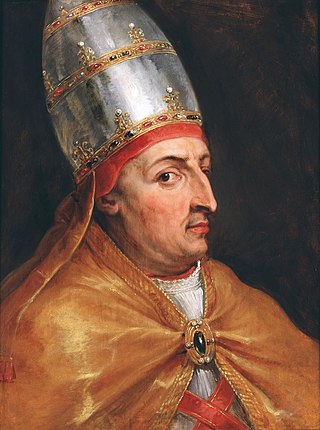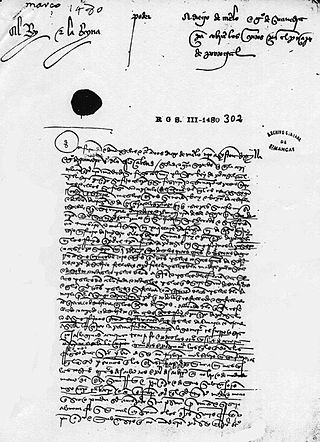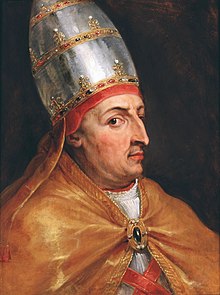
Afonso V, known by the sobriquet the African, was king of Portugal from 1438 until his death in 1481, with a brief interruption in 1477. His sobriquet refers to his military conquests in Northern Africa.

Pope Alexander VI was head of the Catholic Church and ruler of the Papal States from 11 August 1492 until his death in 1503. Born into the prominent Borgia family in Xàtiva under the Crown of Aragon, Rodrigo studied law at the University of Bologna. He was ordained deacon and made a cardinal in 1456 after the election of his uncle as Pope Callixtus III, and a year later he became vice-chancellor of the Catholic Church. He proceeded to serve in the Curia under the next four popes, acquiring significant influence and wealth in the process. In 1492, Rodrigo was elected pope, taking the name Alexander VI.

Pope Callixtus III, born Alfonso de Borgia, was head of the Catholic Church and ruler of the Papal States from 8 April 1455 to his death, in August 1458. Borgia spent his early career as a professor of law at the University of Lleida; he later served as a diplomat for the kings of Aragon. He became a tutor for King Alfonso V's illegitimate son Ferdinand. After arranging a reconciliation between Alfonso and Pope Martin V, Borgia was made Bishop of Valencia. In 1444, Pope Eugene IV named him a cardinal, and Borgia became a member of the Roman Curia. During the siege of Belgrade (1456), Callixtus initiated the custom that bells be rung at midday to remind the faithful to pray for the crusaders. The tradition of the Angelus noon bell still exists in most Catholic Churches to this day. He was also responsible for the retrial of Joan of Arc that saw her vindicated. He appointed two nephews as cardinals, one of whom became Pope Alexander VI. He is the last pope to date to take on the pontifical name "Callixtus".

Pope Nicholas V, born Tommaso Parentucelli, was head of the Catholic Church and ruler of the Papal States from 6 March 1447 until his death, in March 1455. Pope Eugene IV made him a cardinal in 1446 after successful trips to Italy and Germany, and when Eugene died the next year, Parentucelli was elected in his place. He took his name Nicholas in memory of his obligations to Niccolò Albergati.

Pope Eugene IV, born Gabriele Condulmer, was head of the Catholic Church and ruler of the Papal States from 11 March 1431 to his death, in February 1447. Condulmer was a Venetian, and a nephew of Pope Gregory XII. In 1431, he was elected pope. His tenure was marked by conflict first with the Colonna, relatives of his predecessor Martin V, and later with the Conciliar movement. In 1434, due to a complaint by Fernando Calvetos, bishop of the Canary Islands, Eugene IV issued the bull "Creator Omnium", rescinding any recognition of Portugal's right to conquer those islands, still pagan. He excommunicated anyone who enslaved newly converted Christians, the penalty to stand until the captives were restored to their liberty and possessions. In 1443 Eugene decided to take a neutral position on territorial disputes between Portugal and Castile regarding rights claimed along the coast of Africa. He also issued "Dundum ad nostram audientiam", which was the legal basis for the creation of Jewish ghettos in Europe.

The Treaty of Tordesillas, signed in Tordesillas, Spain, on 7 June 1494, and ratified in Setúbal, Portugal, divided the newly discovered lands outside Europe between the Portuguese Empire and the Spanish Empire, along a meridian 370 leagues west of the Cape Verde islands, off the west coast of Africa. That line of demarcation was about halfway between the Cape Verde islands and the islands visited by Christopher Columbus on his first voyage, named in the treaty as Cipangu and Antillia.
The Latin title Rex Catholicissimus, anglicised as Most Catholic King or Most Catholic Majesty, was awarded by the Pope to the Sovereigns of Spain. It was first used by Pope Alexander VI in the papal bull Inter caetera in 1493.

The Treaty of Alcáçovas was signed on 4 September 1479 between the Catholic Monarchs of Castile and Aragon on one side and Afonso V and his son, Prince John of Portugal, on the other side. It put an end to the War of the Castilian Succession, which ended with a victory of the Castilians on land and a Portuguese victory on the sea. The four peace treaties signed at Alcáçovas reflected that outcome: Isabella was recognized as Queen of Castile while Portugal reached hegemony in the Atlantic Ocean.
The papal bull Aeterni regis [English: "Of the eternal king"] was issued on 21 June 1481 by Pope Sixtus IV. It confirmed the substance of the Treaty of Alcáçovas, reiterating that treaty's confirmation of Castile in its possession of the Canary Islands and its granting to Portugal all further territorial acquisitions made by Christian powers in Africa and eastward to the Indies.

Inter caetera was a papal bull issued by Pope Alexander VI on the 4 May 1493, which granted to the Catholic Monarchs King Ferdinand II of Aragon and Queen Isabella I of Castile all lands to the "west and south" of a pole-to-pole line 100 leagues west and south of any of the islands of the Azores or the Cape Verde islands.
Sublimis Deus is a bull promulgated by Pope Paul III on June 2, 1537, which forbids the enslavement of the indigenous peoples of the Americas and all other people who could be discovered later. It states that the Indians are fully rational human beings who have rights to freedom and private property, even if they are heathen. Another related document is the ecclesiastical letter Pastorale officium, issued May 29, 1537, and usually seen as a companion document to Sublimis Deus.
Romanus Pontifex praising Catholic King Afonso V of Portugal for his battles against the Muslims, endorsing his military expeditions into Western Africa and instructing him to capture and subdue all Saracens, Turks, and other non-Christians to reduce their persons to perpetual slavery. The Church leaders argued that slavery served as a natural deterrent and Christianizing influence to “barbarous” behavior among pagans. As a follow-up to the bull Dum Diversas, the church leaders now took positions aside the Crown of Portugal that it was entitled to dominion over all lands south of Cape Bojador in Africa. The bull's primary purpose was to forbid other Christian kings from infringing the King of Portugal's practice of trade and colonisation in these regions, particularly amid the Portuguese and Castilian competition for ascendancy over new lands discovered.

The Catholic Church during the Age of Discovery inaugurated a major effort to spread Christianity in the New World and to convert the indigenous peoples of the Americas and other indigenous peoples. The evangelical effort was a major part of, and a justification for, the military conquests of European powers such as Portugal, Spain, and France. Christian missions to the indigenous peoples ran hand-in-hand with the colonial efforts of Catholic nations. In the Americas and other colonies in Asia, and Africa, most missions were run by religious orders such as the Franciscans, Dominicans, Augustinians, and Jesuits. In Mexico, the early systematic evangelization by mendicants came to be known as the "Spiritual Conquest of Mexico".
The discovery doctrine, or doctrine of discovery, is a disputed interpretation of international law during the Age of Discovery, introduced into United States municipal law by the US Supreme Court Justice John Marshall in Johnson v. McIntosh (1823). In Marshall's formulation of the doctrine, discovery of territory previously unknown to Europeans gave the discovering nation title to that territory against all other European nations, and this title could be perfected by possession. A number of legal scholars have criticized Marshall's interpretation of the relevant international law. In recent decades, advocates for Indigenous rights have campaigned against the doctrine. In 2023, the Vatican formally repudiated the doctrine.
Sicut dudum was a papal bull promulgated by Pope Eugene IV in Florence on January 13, 1435, which forbade the enslavement of the natives of the Canary Islands who had converted, or were converting to, Christianity. Sicut dudum was meant to reinforce Creator Omnium, issued the previous year, condemning Portuguese slave raids in the Canary Islands.

The Bulls of Donation, also called the Alexandrine Bulls, and the Papal donations of 1493, are three papal bulls of Pope Alexander VI delivered in 1493 which granted overseas territories to Portugal and the Catholic Monarchs of Spain.

Creator Omnium was a papal bull issued by Pope Eugene IV in 1434 which excommunicated anyone who enslaves Christians of the Canary Islands.

Dudum siquidem is a papal bull issued by Pope Alexander VI on 26 September 1493, one of the Bulls of Donation addressed to the Catholic Monarchs Isabella I of Castile and Ferdinand II of Aragon which supplemented the bull Inter caetera and purported to grant to them "all islands and mainlands whatsoever, found and to be found, discovered and to be discovered, that are or may be or may seem to be in the route of navigation or travel towards the west or south, whether they be in western parts, or in the regions of the south and east and of India".
Eximiae devotionis declared on 3 May 1493 is one of three papal bulls of Pope Alexander VI delivered purporting to grant any and all overseas territories in the west and ocean to kings of Castile and León that were found by the kings of Castile and León provided those territories were not already in the possession of another Christian lord. The document in addition to Inter caetera delivered on 4 May 1493 and Dudum siquidem delivered on 26 September 1493 make up what is known as the Bulls of Donation.
"Papal donation" refers to two sets of papal bulls by which Pope Nicholas V, in 1454, and Pope Alexander VI, in 1493, purported to give the Catholic monarchs of Portugal and Spain, respectively, the prerogative to explore the Americas. Alexander's bull, proclaimed on 4 May 1493, was titled Inter caetera and addressed to Ferdinand and Isabella, the Catholic Monarchs of Spain, and later Catholic monarchs of Spain. England and France opposed the papal donation. Jurists including Francisco de Vitoria and Francisco Suárez argued that the pope did not have power to award territory to sovereigns.













